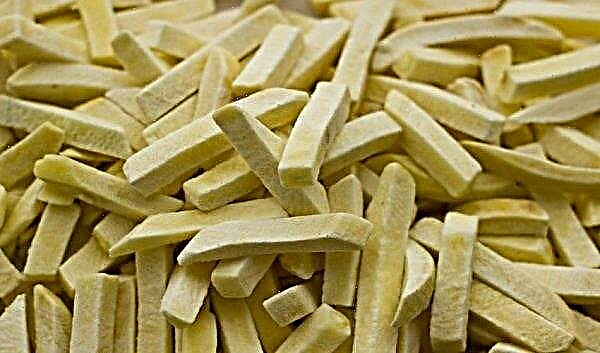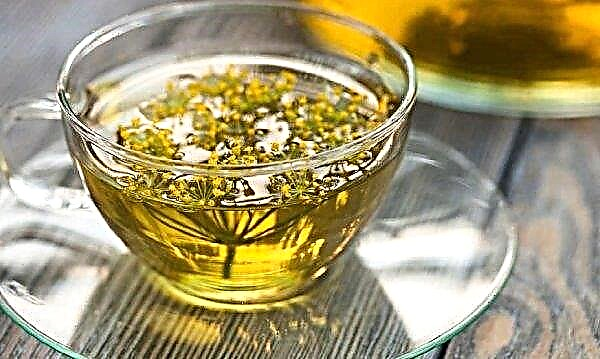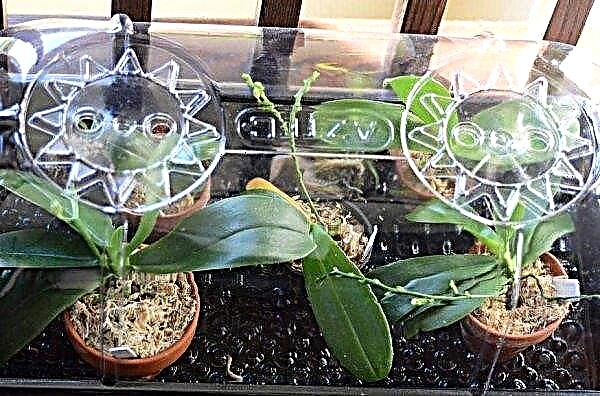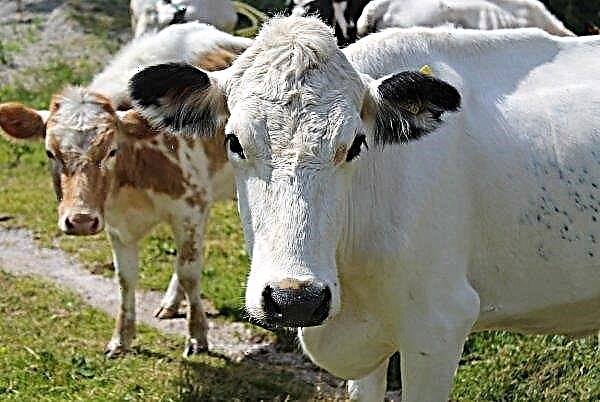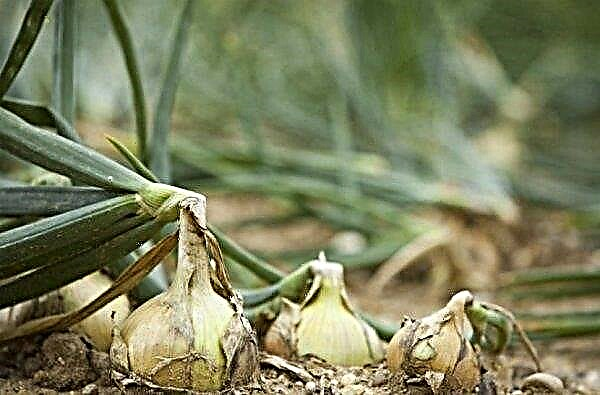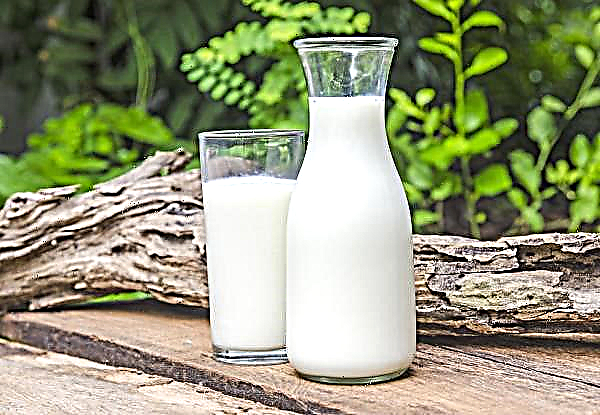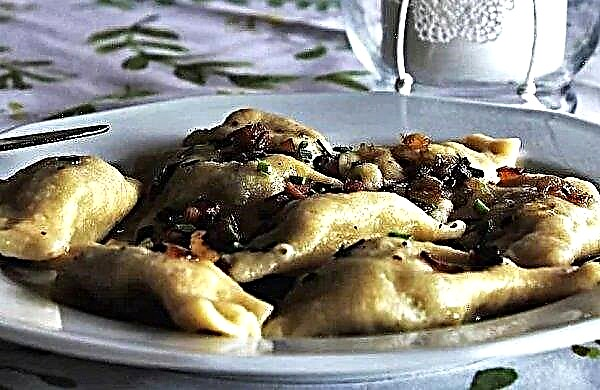Raspberries are a popular berry both among gardeners and breeders. A huge number of varieties has been developed, choosing one of which is not easy. Before planting your favorite varietal specimen on the site, you should familiarize yourself with its full description, characteristics and preferences. The article will talk about the repairing grade of Augustine.
Selection history
Augustin variety was created by Russian breeders I. Kazakov and S. Evdokimenko through interspecific hybridization. Today it is actively used to develop new varieties, trying to convey the best qualities to them.
Did you know? In the world there are varieties of raspberries not only with red berries. They can be black, pink, yellow, orange and purple. The latter variety is the result of the random crossing of red and black berries growing in North America not far from each other.
Description
The bushes of the variety grow medium in height - up to 1.6 m, compact. Can be grown in a small area. Shoots are strong, straight-growing, strewn with small spikes. The leaves are large, dark green in color, wrinkled, not pubescent.

The berries are formed medium in size, conical in shape with a blunt finish, weighing 6-8 g. They are painted in dark red color, have a delicate flesh with a sweet taste. The purpose of the berries is universal - they are suitable for fresh consumption, cooking jams, preserves, drinks.
Advantages and disadvantages
- Gardeners who have had the experience of growing Augustine raspberries note the following among its positive characteristics:
- high productivity;
- good resistance to fungal and viral infections, raspberry mite;
- lack of need for a garter;
- large berries;
- high sugar content in fruits (up to 6%);
- preservation of taste and market characteristics of the fruit after transportation.
Drought resistance, frost resistance
Among the minuses of the variety are poor tolerance of droughts and an average level of frost resistance - bushes can withstand temperatures lowering to –21 ... –24˚C.
Productivity and fruiting
Augustine is an early-ripening cultivar. It bears fruit twice a season: the first time - until June 10, the second - at the end of summer. The second fruiting is usually more plentiful and lasts until the first frost. The berries are not prone to shedding, after ripening they can remain on the branches for up to 10 days. The yield of the variety is 4-5 kg from a bush or 12 tons from 1 hectare.

Landing Features
The rules for planting and caring for Augustine raspberries are recommended the same as for all repair varieties. The success of the cultivation will depend on the selection of a suitable place for planting, the acquisition of high-quality seedlings and compliance with planting technology.
The timing
You can plant the plant in spring - in April or in autumn - in October. It is important not to miss the recommended dates in the autumn period, so that the plant has time to adapt to resistant frosts. If for some reason it was not possible to plant the harvested seedling in October, you can put it in the cool store for the winter to keep the young plant until spring.
Choosing the right place
The area for planting raspberry bushes should be open, well-lit by sunlight. On the north side - protected from drafts. If you plant the plants in the shade, then the berries will have smaller sizes, lower sugar content and ripen later. When selecting a landing site, it is necessary to determine the level of groundwater location. They should lie at a depth of 1-1.5 m from the surface.
Raspberry gives the best harvests when planting in fertilized loamy and sandy loamy soils, which allow moisture and air to pass through well. Augustine variety is demanding on soil fertility. The optimum level of soil acidity for it is in the range from 5.8 pH to 6.7 pH.

Selection and preparation of planting material
The seedling can be prepared independently or purchased. You should not buy it from unverified sellers, by hand, since in this case there is no guarantee that you will receive the desired variety and healthy plant. The purchase should be carried out in a specialized store or garden nursery.
The seedling must be chosen low, the number of shoots - from two to four, with three or more buds at the base, with a healthy open root system. Before planting, the root system must be kept for several hours in a bucket of water. Foliage and shoots should be removed.
Important! It is worth refusing to purchase planting material with a sluggish or dry rhizome, open kidneys.
Landing algorithm
Sequencing:
- 1-2 weeks before planting, dig trenches 30–40 cm deep at a distance of 1.5–2 m from each other.
- Fertilize the soil with humus (16–18 kg / 1 linear meter), add lime (0.3 kg) and wood ash (0.5 kg).
- In the trenches, make holes with intervals of 50–70 cm.
- Set seedlings in the pits so that the root neck rises on the same level with the soil surface.
- Fill the wells with fertile soil.
- Moisturize the planting, spending 5-8 liters of water under each bush.
- Trim to a height of 30–40 cm.
- Mulch the soil with peat, sawdust.

Care Rules
Caring for raspberry bushes involves the following mandatory and regular procedures:
- watering;
- top dressing;
- pruning branches;
- loosening;
- weeding;
- mulching.
Watering for bushes need moderate. Intensive is required only during drought, flowering and fruiting. Humidification should be done once a week, using 1-2 buckets for each bush.
Important! A lack of moisture leads to the formation of small and acidic fruits, as well as a significant decrease in productivity.
In order for the plants to be healthy and the crops to be plentiful, they need to be fed regularly. Best raspberry responds to organic dressing. They can be alternated with mineral mixtures. The interval between dressings should be at least two weeks.
Fertilizer options that can be applied at different times of raspberry development:
- Bird droppings. Feeding is carried out by infusion, which is prepared from 7 kg of litter, diluted in a bucket of water and infused for a week.
- A mixture of manure with grass in a ratio of 1: 1.
- Mullein is rotten.
- A mixture of manure with wood ash. Cooking technology: fill 1/3 of the manure bucket to the top with water, insist 2 days. Before use, dilute 1:10 with water and pour 1 cup of wood ash.
- Urea (40 g / m²).
- A mixture of ammonium nitrate with urea (10 g and 8 g per square meter, respectively).
- A mixture of ammonium sulfate (15 g / m²) with wood ash (1 cup / m²).
- Complex fertilizer (3 tbsp. L. Per 10 liters of water).
- A mixture of potassium salt, ammonium nitrate, superphosphate (40 g + 30 g + 60 g + 10 l of water).
- A mixture of manure, urea, superphosphate, potassium salt (1.5 kg + 3 g + 2 g + 3 g + 10 l of water).

The day after each irrigation and rain it is required to loosen the soil. Loosening is necessary so that a dense crust does not form on the surface of the soil, preventing the penetration of water and air to the root system. To prevent the reproduction of diseases and harmful insects on the site, it must be regularly cleaned of weeds.
To maintain the necessary level of humidity, to control the growth of weeds and to reduce the number of loosening and weeding, mulching is necessary. As mulch, manure, humus, peat, compost, straw, sawdust, foliage are suitable.
For Augustin, annual pruning is mandatory. They help increase productivity and prevent the development of diseases. In the first year, you need to remove all root shoots. In the second, complete cropping.

If you adhere to such recommendations, you can achieve an abundant second fruiting. If you do not touch the young shoots during the autumn pruning, then they will bear fruit in the summer, and in the fall the newly grown branches will bear fruit.
Winter preparations
Since the level of winter hardiness in Augustin bushes is low, it is necessary for them to organize shelter before winter. After trimming the plants, they need to be covered with a thick layer of mulch, agrofibre or spruce branches. As you settle, you need to regularly pour a high layer of mulch.
Breeding methods
Augustin variety bushes can be propagated in two ways: young shoots and root cuttings. Sprouts suitable for propagation are cut in the summer with a sharp knife, secateurs. They should be 7-10 cm long. Then they need to be rooted.

First, the cuttings are kept in the root for 12-15 hours, and then placed in the soil at a distance of 7-10 cm from each other, covered with a film. The optimum temperature for growth and rooting is from + 22 ° to + 25 ° C. After a month, the roots should appear. Then the cuttings can be transplanted to a permanent place of growth.
Root cuttings are harvested in spring during transplantation of raspberry bushes, or in autumn, after the end of the growing process. From the mother plant, those cuttings that are 2 cm thick are separated. They should be rooted in the ground so that 3-4 shoots of rhizomes appear, and planted as seedlings in pre-prepared holes. An earthen lump does not collapse upon landing.
They should be rooted in the ground so that 3-4 shoots of rhizomes appear, and planted as seedlings in pre-prepared holes. An earthen lump does not collapse upon landing.
Harvesting and storage
It is necessary to start harvesting the fruits when they have reached absolute maturity - they will acquire a red color, the size and weight declared by the originator. Harvesting is planned for a day without precipitation, when the berries dry out of dew. Only fruits harvested in a dry state can be stored for as long as possible.
Cleaning is done by hand. Berries are carefully separated from the stem. Those specimens that are intended for transportation are removed together with the receptacle, and the stem is removed by cutting or pinching. Fruits must be immediately cooled to 0 ... + 0.5 ° C. Once the crop is harvested, it should be placed in cold conditions. The shorter the period from collection to placement in the cold, the longer the shelf life.
Did you know? The leader in terms of fruit size among all raspberry varieties is Giant. On the bushes of this crop, with good care and favorable growing conditions, berries up to 25 g can form.
In the refrigerator, at a temperature of + 8 ... + 10 ° С, raspberries can be stored for 2-3 days. To preserve the berries for up to a week, they need to be stored in temperature conditions from + 4 ° C to + 5 ° C. Transportation of chilled fruits may be carried out at + 10 ... + 15 ° С. So, Augustine raspberries can be recommended for cultivation in suburban areas. It brings tasty fruits twice a season, is unpretentious in leaving, has strong immunity.


